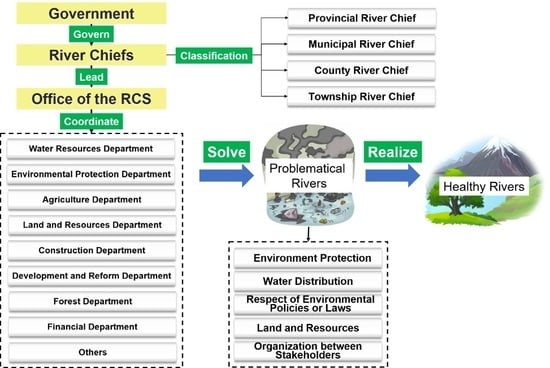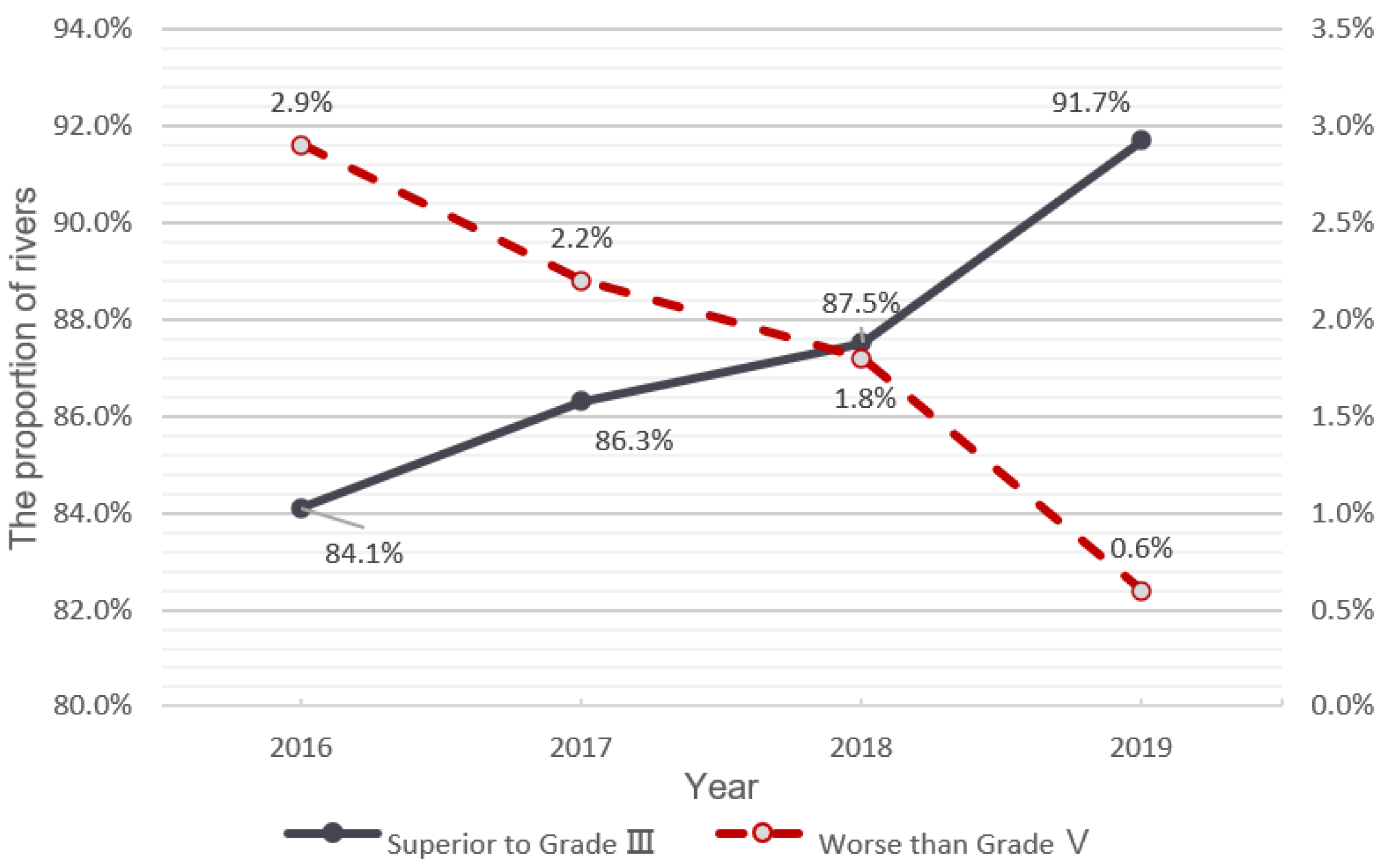Full Implementation of the River Chief System in China: Outcome and Weakness
Abstract
1. Introduction
2. Materials and Methods
3. Results
3.1. Development of RCS after full Implementation as of December, 2016
3.1.1. The Implementation of the Lake Chief System (LCS)
3.1.2. One River (or Lake), One Document: The Survey and Evaluation of Water Environment
3.1.3. One River (or Lake), One Strategy: The Programming Guide
3.1.4. Legislation on RCS and LCS after Full Implementation
3.1.5. Recent Progress in Public Participation in the Fully Implemented RCS
3.2. The Outcomes of the Development of the RCS
3.2.1. Water Quality Improvement in the Past Three Years
3.2.2. Water Quality Improvement in the Yangtze River Basin
3.2.3. Water Quality Improvement in the Taihu Lake Basin
4. Discussion
4.1. The Superiority and Necessity of the RCS
4.2. The Weaknesses of RCS and the Possible Solutions
5. Conclusions
Author Contributions
Funding
Conflicts of Interest
References
- McGuire, M. Collaborative public management: Assessing what we know and how we know it. Public Admin. Rev. 2006, 66, 33–43. [Google Scholar] [CrossRef]
- Head, B.W.; Alford, J. Wicked problems: Implications for pullie poliey and management. Adm. Soc. 2015, 47, 711–739. [Google Scholar] [CrossRef]
- Wang, Y. Diagnosis and recommendations for transjurisdictional water pollution management in China. Front. Environ. Sci. En. 2007, 1, 401–417. [Google Scholar] [CrossRef]
- Wang, Y.; Chen, X. River chief system as a collaborative water governance approach in China. Int. J. Water Resour. D. 2019. [Google Scholar] [CrossRef]
- Molle, F.; Wester, P.; Hirsch, P. River basin development and management. Water for Food—Water for Life: A Comprehensive Assessment of Water Management in Agriculture. Int. Water Manag. Inst. 2007. [Google Scholar] [CrossRef]
- Molle, F. River-basin planning and management: The social life of a concept. Geoforum 2009, 40, 484–494. [Google Scholar] [CrossRef]
- Biswas, A.K.; Varis, O.; Tortajada, C. Integrated Water Resources Management in South and Southeast Asia; Oxford University Press: Oxford, UK, 2005. [Google Scholar]
- Biswas, A. Integrated water resources management: Is it working? Int. J. Water Resour. D 2008, 24, 5–22. [Google Scholar] [CrossRef]
- Zhu, X. Review of achievements for ten years in the field that the river chiefsystem established in Wuxi. Water Resour. D Manag. 2018, 4, 16–22. (In Chinese) [Google Scholar]
- Central People’s Government of the People’s Republic of China, the Opinions on Full Implementation of the River Chief System Across the Country. Available online: http://www.gov.cn/xinwen/2016-12/11/content_5146628.htm?allContent (accessed on 11 December 2016). (In Chinese)
- Chien, S.S.; Hong, D.L. River leaders in China: Party-state hierarchy and transboundary governance. Polit. Geogr. 2018, 62, 58–67. [Google Scholar] [CrossRef]
- Wang, L.F.; Li, Y. Chinese scheme to resolve the current complicated water issues: River chief system (RCS). Earth Environ. Sci. 2018, 191, 012019. [Google Scholar] [CrossRef]
- Liu, H.; Chen, Y.D.; Liu, T.; Lin, L. The River Chief System and river pollution control in China: A Case Study of Foshan. Water 2019, 11, 8. [Google Scholar] [CrossRef]
- Huang, Q.; Xu, J. Rethinking environmental bureaucracies in River Chiefs System (RCS) in China: A critical literature study. Sustainability 2019, 11, 1608. [Google Scholar] [CrossRef]
- Ren, M. The River chief system: A case study of China’s inter-departmental coordination for watershed treatment. J. Beijing Adm. Inst. 2015, 3, 25–31. (In Chinese) [Google Scholar]
- China National Environmental Monitoring Centre. The Weekly Report on Automatic Water Quality Monitoring of Major River Basins and Key Sections of Lakes and Reservoirs in China. Available online: http://www.cnemc.cn/sssj/szzdjczb/index.shtml (accessed on 20 February 2020). (In Chinese).
- Ministry of Ecology and Environment of the People’s Republic of China. The Weekly Report on Automatic Water Quality Monitoring of Major River Basins and Key Sections of Lakes and Reservoirs in China. Available online: http://www.mee.gov.cn/hjzl/shj/qgdbszlzk/ (accessed on 20 February 2020). (In Chinese)
- Ministry of Water Resources of the People’s Republic of China. The notification of implementation opinions on the promotion of the River Chief System from ‘in name’ to ‘in practice’. Available online: http://www.mwr.gov.cn/zw/tzgg/tzgs/201810/t20181011_1052495.html (accessed on 11 October 2018). (In Chinese)
- Ministry of Water Resources of the People’s Republic of China. To Promote the Transformation of the River Chief System from ‘in Name’ to ‘in Practice’. Available online: http://jazx.mwr.cn/slyw/201810/t20181012_1052538.html (accessed on 12 October 2018). (In Chinese)
- Ministry of Water Resources of the People’s Republic of China. Key Points of River and Lake Management Issues in 2020. Available online: http://www.mwr.gov.cn/zwgk/zfxxgkml/202003/t20200311_1391819.html (accessed on 5 March 2020). (In Chinese)
- What Is the Distribution Status of Lakes in China? Available online: http://guoqing.china.com.cn/2017-01/11/content_40083987.htm (accessed on 11 January 2017). (In Chinese).
- Central People’s Government of the People’s Republic of China. Guiding Opinions on the Implementation of Lake Chief System (LCS) in Lakes. Available online: http://www.gov.cn/zhengce/2018-01/04/content_5253253.htm (accessed on 4 January 2018). (In Chinese)
- Ministry of Water Resources of the People’s Republic of China. Guiding Opinions on the Implementation of Lake Chief System (LCS) in Lakes’. Available online: http://www.mwr.gov.cn/ztpd/gzzt/hzz/zyjs/201801/t20180105_1019466.html (accessed on 5 January 2018). (In Chinese)
- Central People’s Government of the People’s Republic of China. The Ministry of Water Resources Held a Press Conference on the Comprehensive Establishment of the LCS. Available online: http://www.gov.cn/xinwen/2019-01/26/content_5361369.htm#1 (accessed on 26 January 2019). (In Chinese)
- Ministry of Water Resources of the People’s Republic of China. The Guide for ‘One River (or Lake), One Document’ Programming. Available online: http://www.mwr.gov.cn/zwgk/zfxxgkml/201805/t20180514_1037385.html (accessed on 13 April 2018). (In Chinese)
- Ji, X.; Dahlgren, R.A.; Zhang, M. Comparison of seven water quality assessment methods for the characterization and management of highly impaired river systems. Environ. Monit. Assess. 2016, 188, 1–15. [Google Scholar] [CrossRef] [PubMed]
- Bhateria, R.; Jain, D. Water quality assessment of lake water: A review. Sustain. Water Resour. Manag. 2016, 2, 161–173. [Google Scholar] [CrossRef]
- Souza, G.B.G.; Vianna, M. Fish-based indices for assessing ecological quality and biotic integrity in transitional waters: A systematic review. Ecol. Indic. 2020, 109, 105665. [Google Scholar] [CrossRef]
- Li, Y.; Yang, N.; Qian, B.; Yang, Z.; Liu, D.; Niu, L.; Zhang, W. Development of a bacteria-based index of biotic integrity (Ba-IBI) for assessing ecological health of the Three Gorges Reservoir in different operation periods. Sci.Total Environ. 2018, 640, 255–263. [Google Scholar] [CrossRef]
- Niu, L.; Li, Y.; Wang, P.; Zhang, W.; Wang, C.; Li, J.; Wu, H. Development of a microbial community-based index of biotic integrity (MC-IBI) for the assessment of ecological status of rivers in the Taihu Basin, China. Ecol. Indic. 2018, 85, 204–213. [Google Scholar] [CrossRef]
- Li, J.; Li, Y.; Qian, B.; Niu, L.; Zhang, W.; Cai, W.; Wu, H.; Wang, P.; Wang, C. Development and validation of a bacteria-based index of biotic integrity for assessing the ecological status of urban rivers: A case study of Qinhuai River basin in Nanjing, China. J. Environ. Manag. 2017, 196, 161–167. [Google Scholar] [CrossRef]
- Ministry of Water Resources of the People’s Republic of China. Legal Basis of the Duty Execution of River Chiefs—An Interpretation on the Regulations for Rcs in Zhejiang Province. Available online: http://www.mwr.gov.cn/ztpd/gzzt/hzz/jcsj/201710/t20171024_1004713.html (accessed on 24 October 2017). (In Chinese)
- Enserink, B.; Koppenjan, J. Public participation in China: Sustainable urbanization and governance. Manag. Environ. Qual. 2007, 18, 459–474. [Google Scholar] [CrossRef]
- Nanjing Water. The Government of Gulou District, Nanjing and Hohai University Held a Cooperation Signing Ceremony on "Expert River Chief". Available online: http://shuiwu.nanjing.gov.cn/bmdt/201911/t20191115_1708965.html (accessed on 15 November 2019). (In Chinese)
- Hebnews, Civilian River Chief: To Promote Rcs Into Long Term Effects. Available online: http://comment.hebnews.cn/2019-07/26/content_7440618.htm (accessed on 26 July 2019). (In Chinese).
- Mznews, to Take Advantages of the Roles of the Entrepreneur River Chiefs. Available online: http://news.thmz.com/col50/2019-07-02/1208090.html (accessed on 2 July 2019). (In Chinese).
- Ministry of Ecology and Environment of the People’s Republic of China. The Ministry of Ecology and Environment Announced the National Surface Water and Ambient Air Quality in 2019. Available online: http://www.mee.gov.cn/xxgk2018/xxgk/xxgk15/202001/t20200123_760936.html (accessed on 23 January 2020). (In Chinese)
- Liu, X. The progress and consideration of RCS in the middle and upper reaches of Yangtze river. Express Water Resour. Hydropower Inf. 2019, 7, 8–12. (In Chinese) [Google Scholar]
- Liu, X.; Pan, Y.; Zhang, W.; Ying, L.; Huang, W. Achieve Sustainable development of rivers with water resource management—economic model of river chief system in China. Sci. Total Environ. 2020, 708, 134657. [Google Scholar] [CrossRef] [PubMed]
- Guo, Q.H.; Wu, J.J.; Xiao, L.S. Promoting ecosystem services through ecological planning in the Xianghe Segment of China’s Grand Canal. Int. J. Sustain. Dev. World Ecol. 2016, 23, 365–371. [Google Scholar] [CrossRef]
- Islam, S.; Susskind, L. Using complexity science and negotiation theory to resolve boundary-crossing water issues. J. Hydrol. 2018, 562, 589–598. [Google Scholar] [CrossRef]
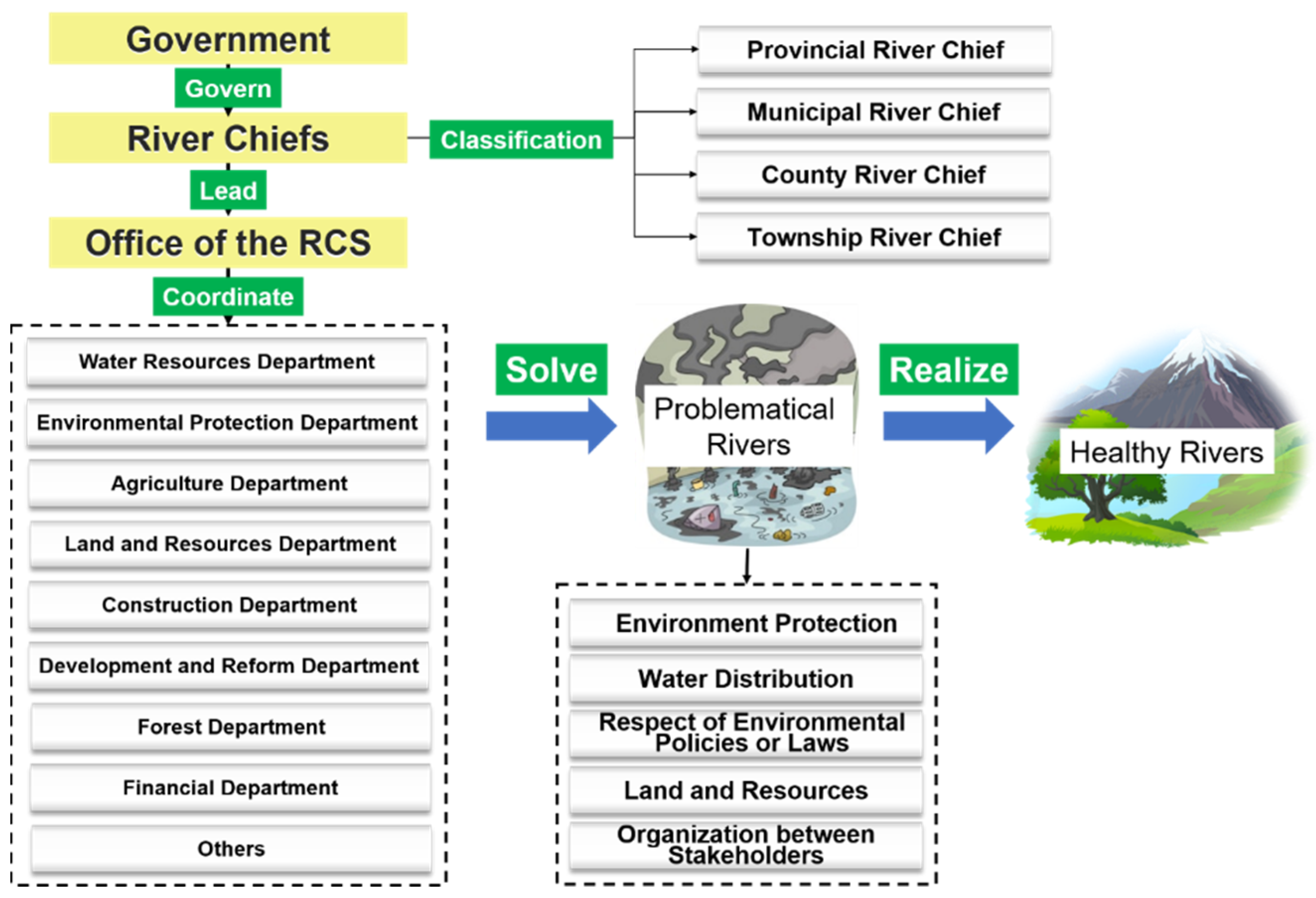
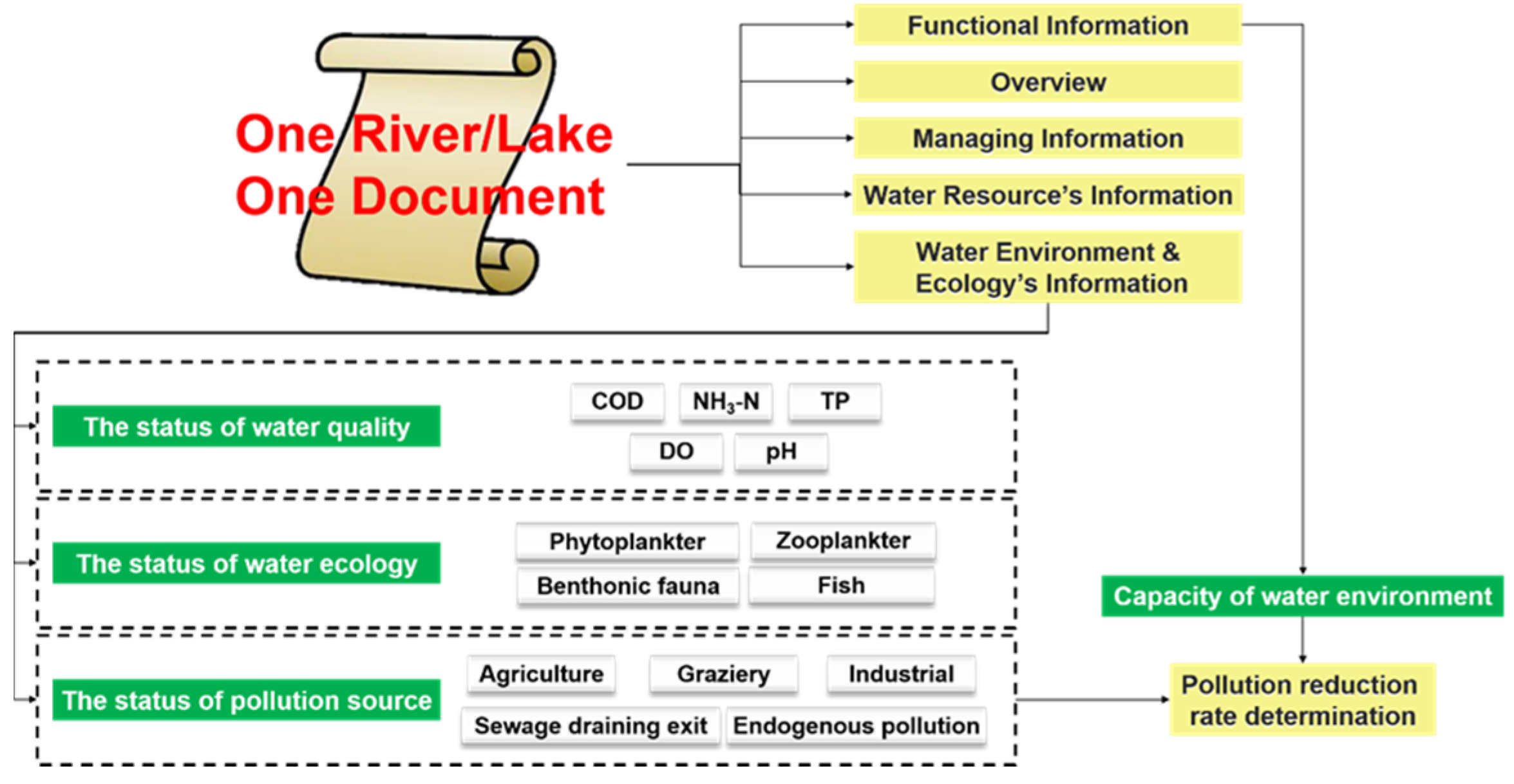
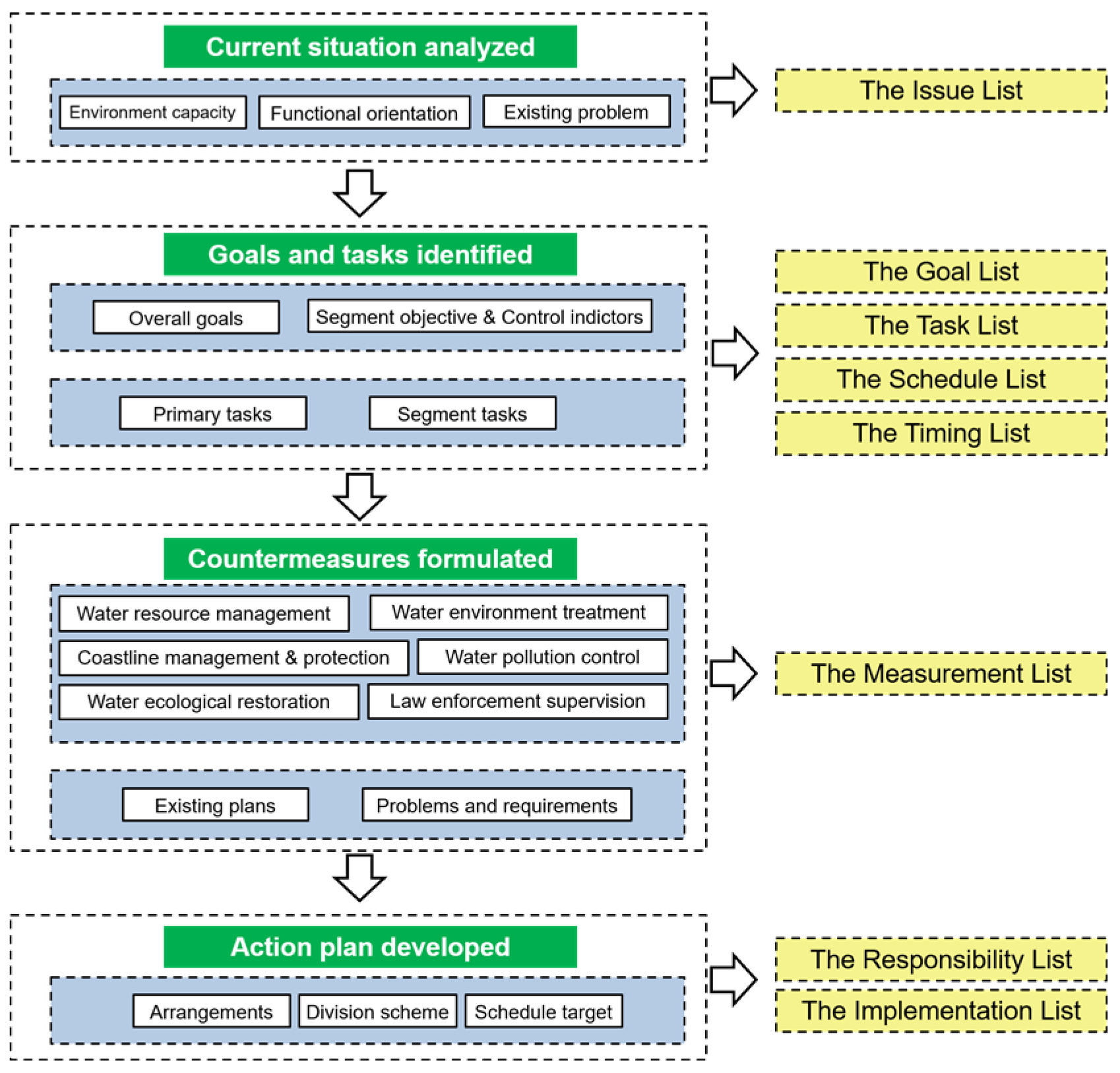
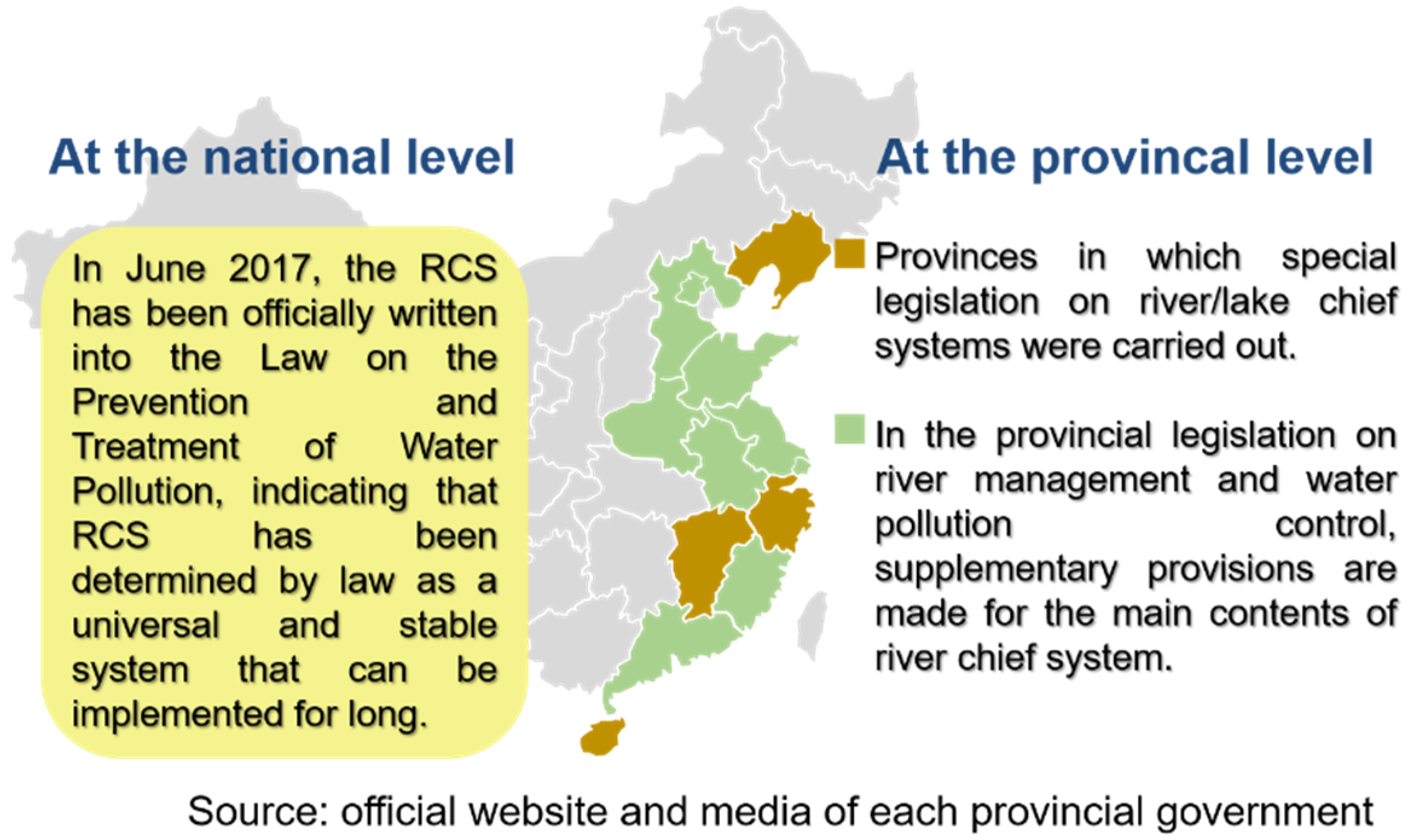
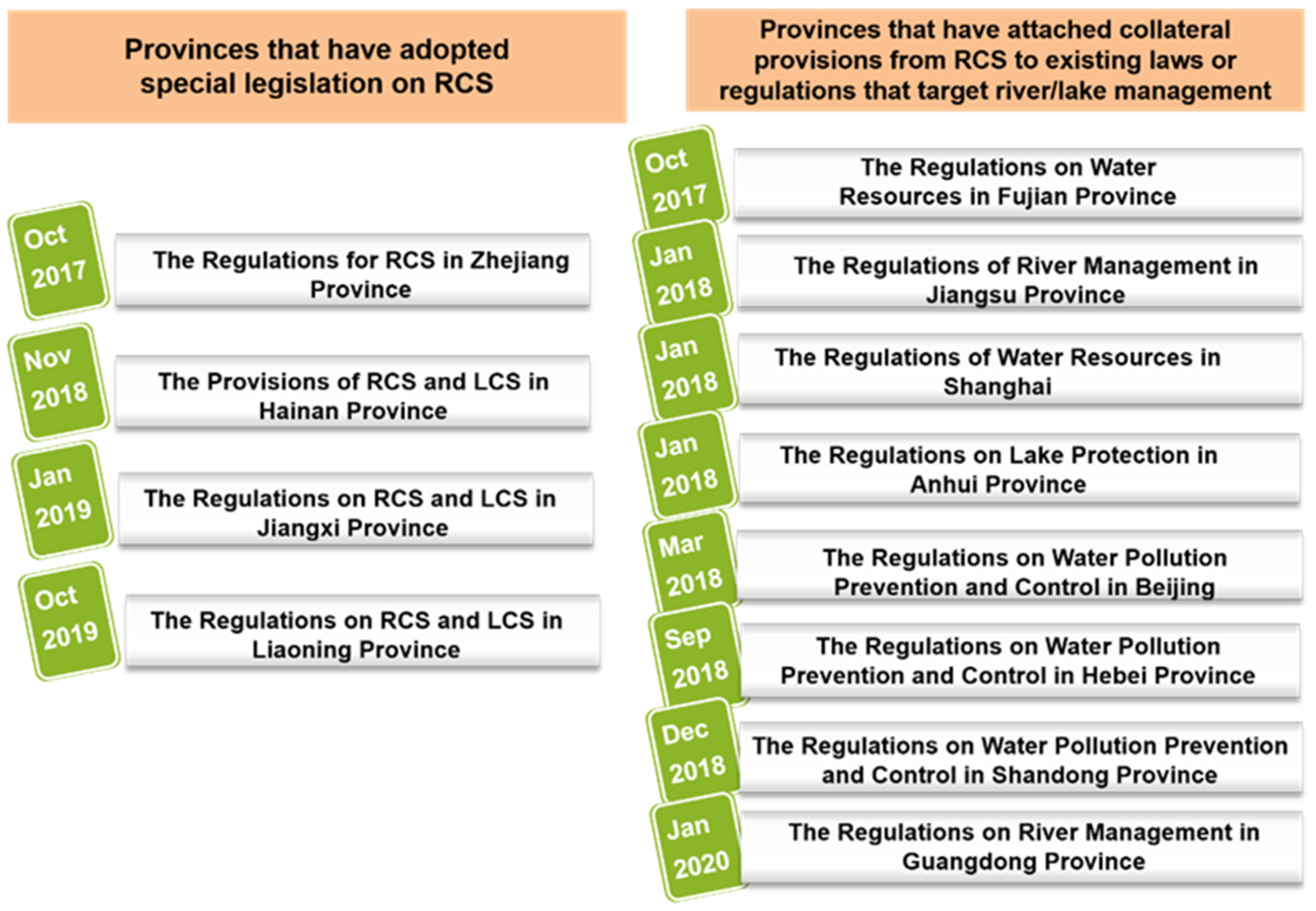

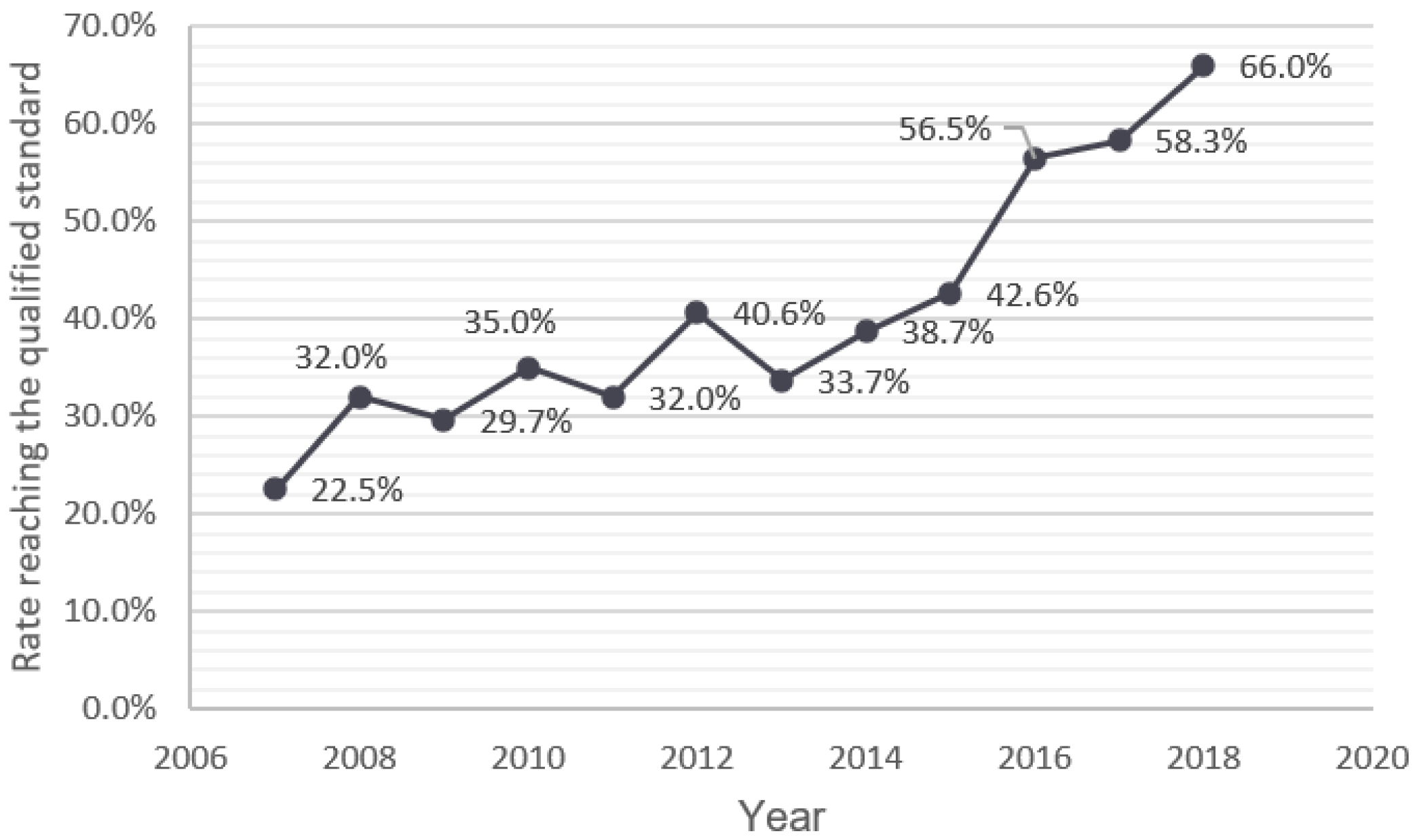
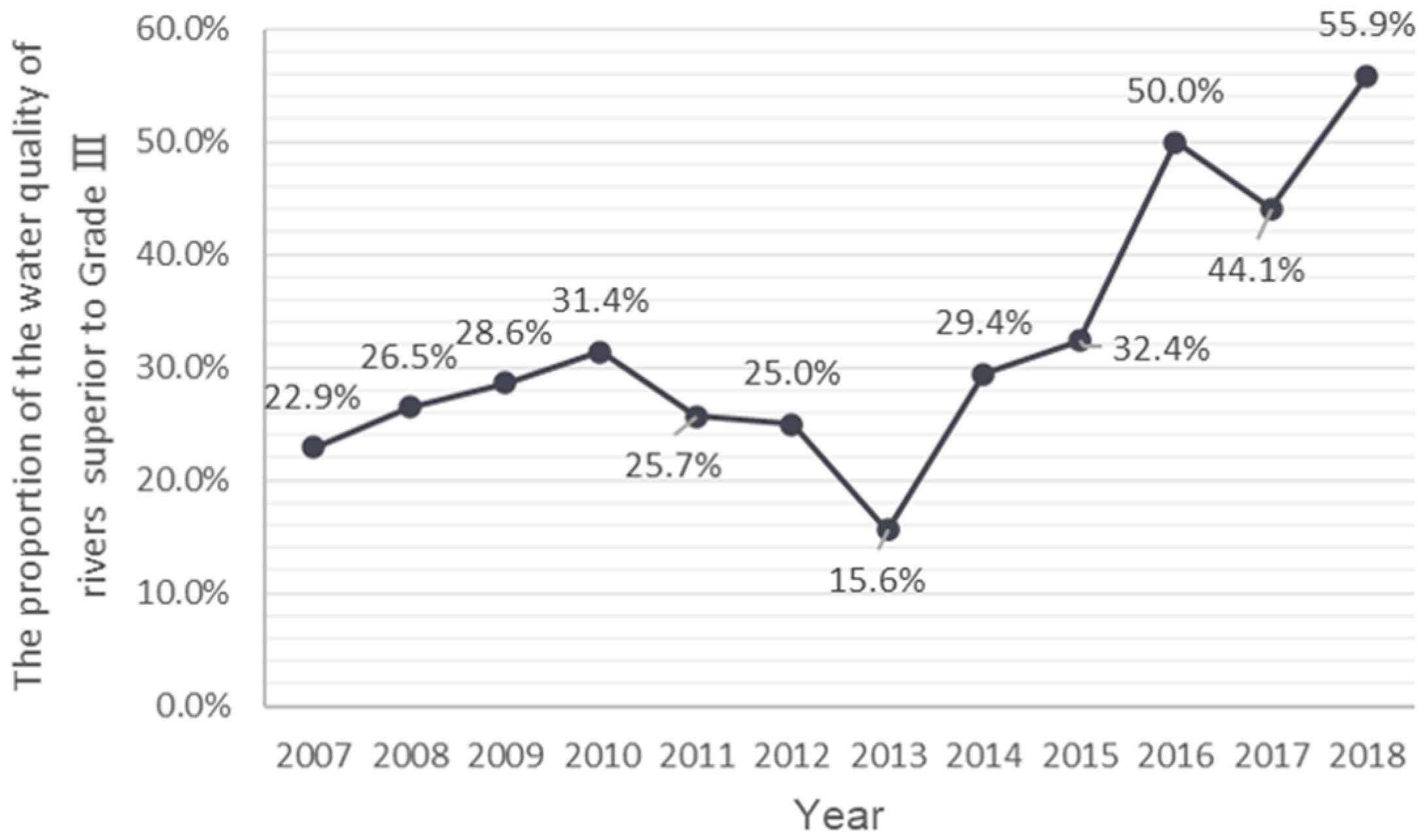
© 2020 by the authors. Licensee MDPI, Basel, Switzerland. This article is an open access article distributed under the terms and conditions of the Creative Commons Attribution (CC BY) license (http://creativecommons.org/licenses/by/4.0/).
Share and Cite
Li, Y.; Tong, J.; Wang, L. Full Implementation of the River Chief System in China: Outcome and Weakness. Sustainability 2020, 12, 3754. https://doi.org/10.3390/su12093754
Li Y, Tong J, Wang L. Full Implementation of the River Chief System in China: Outcome and Weakness. Sustainability. 2020; 12(9):3754. https://doi.org/10.3390/su12093754
Chicago/Turabian StyleLi, Yinghong, Jiaxin Tong, and Longfei Wang. 2020. "Full Implementation of the River Chief System in China: Outcome and Weakness" Sustainability 12, no. 9: 3754. https://doi.org/10.3390/su12093754
APA StyleLi, Y., Tong, J., & Wang, L. (2020). Full Implementation of the River Chief System in China: Outcome and Weakness. Sustainability, 12(9), 3754. https://doi.org/10.3390/su12093754



